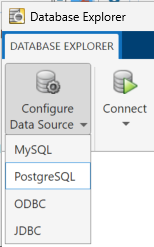Configure PostgreSQL Native Interface Data Source
This tutorial shows how to set up a PostgreSQL native interface data source and connect to a PostgreSQL database using the Database Explorer app or the command line. The tutorial uses the libpq driver version 10.12 to connect to a PostgreSQL version 9.405 database.
The configuration steps show configuring the PostgreSQL native data source on the Windows® platform. The same steps work on Linux® and macOS platforms.
Database Toolbox™ includes the libpq driver. Therefore, you do not have to install and configure the driver.
Step 1. Set up the data source.
You can set up a data source using the Database Explorer app or the command line.
Set Up Data Source Using Database Explorer App
Open the Database Explorer app by clicking the Apps tab on the MATLAB® Toolstrip. Then, on the right of the Apps section, click the Show more arrow to open the apps gallery. Under Database Connectivity and Reporting, click Database Explorer. Alternatively, enter
databaseExplorerat the command line.In the Data Source section, select Configure Data Source > PostgreSQL.

The PostgreSQL Data Source Configuration dialog box opens.

In the Name box, enter the name of your data source. (This example uses a data source named
PostgreSQLDataSource.) You use this name to establish a connection to your database.If you want to store your user credentials for this data source, click the Set Credentials button.
In the Database Name box, enter the name of your database. In the Server box, enter the name of your database server. Consult your database administrator for the name of your database server. In the Port Number box, enter the port number.
Under Connection Options, in the Name column, enter the name of an additional driver-specific option. Then, in the Value column, enter the value of the driver-specific option. Click the plus sign + to specify additional driver-specific options.
Click Test.
If you stored your user credentials using the Set Credentials button, the Database Explorer app attempts to make the connection.
If you have not stored your credentials, the Test Connection dialog box opens. Enter the username and password for your database. Click Test.
If your connection succeeds, the Database Explorer dialog box displays a message indicating the connection is successful. Otherwise, it displays an error message.
Click Save. The PostgreSQL Data Source Configuration dialog box displays a message indicating the data source is saved successfully. Close this dialog box.
Set Up Data Source Using Command Line
Create a PostgreSQL native interface data source for a PostgreSQL database.
vendor = "PostgreSQL"; opts = databaseConnectionOptions("native",vendor);
Set the database connection options. For example, this code assumes that you are connecting to a data source named
PostgreSQLDataSource, database nametoystore_doc, database serverdbtb00, and port number5432.opts = setoptions(opts, ... 'DataSourceName',"PostgreSQLDataSource", ... 'DatabaseName',"toystore_doc",'Server',"dbtb00", ... 'PortNumber',5432);
Test the database connection by specifying the username and password. When a database requires authentication, the recommended practice is to store credentials in your MATLAB vault using
setSecretinstead of including them in your code. Retrieve your credentials by using thegetSecretfunction.Before R2024a:
setSecretandgetSecretare not available. Specify your username and password using character vectors or strings.setSecret("usernamepostgresql"); setSecret("passwordpostgresql"); status = testConnection(opts,getSecret("usernamepostgresql"),getSecret("passwordpostgresql"));
Save the data source.
saveAsDataSource(opts)
After you complete the data source setup, connect to the PostgreSQL database using the Database Explorer app or the command line.
Step 2. Connect using the Database Explorer app or the command line.
Connect to PostgreSQL Using Database Explorer App
On the Database Explorer tab, in the Connections section, click Connect and select the data source for the connection.
If you stored your user credentials using the Set Credentials button, the Database Explorer app makes the connection and the Catalog and Schema dialog box opens.
If you have not stored your user credentials, the connection dialog box opens. Enter your username and password. Click Connect and the Catalog and Schema dialog box opens.
Select the catalog and schema from the Catalog and Schema lists. Click OK.
The app connects to the database and displays its tables in the Data Browser pane. A data source tab appears to the right of the pane. The title of the data source tab is the data source name that you defined during the setup. The data source tab contains empty SQL Query and Data Preview panes.
Select tables in the Data Browser pane to query the database.
Close the data source tab to close the SQL query. In the Connections section, close the database connection by clicking Close Connection.
Note
If multiple connections are open, close the database connection of your choice by selecting the corresponding data source from the Close Connection list.
Connect to PostgreSQL Using Command Line
Connect to a PostgreSQL database using the configured PostgreSQL native interface data source, username, and password.
datasource = "PostgreSQLDataSource"; setSecret("usernamepostgresql"); setSecret("passwordpostgresql"); conn = postgresql(datasource,getSecret("usernamepostgresql"),getSecret("passwordpostgresql"));
Close the database connection.
close(conn)